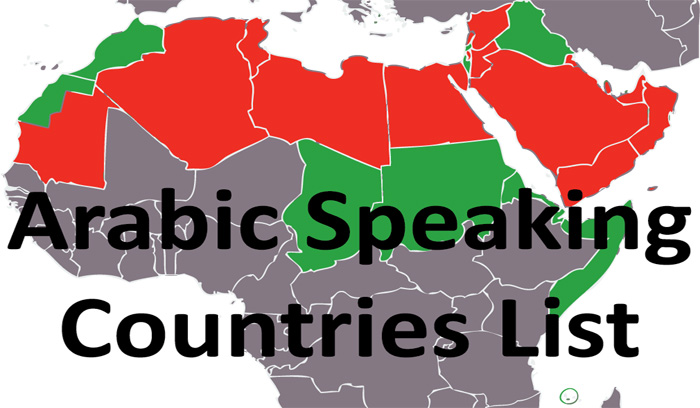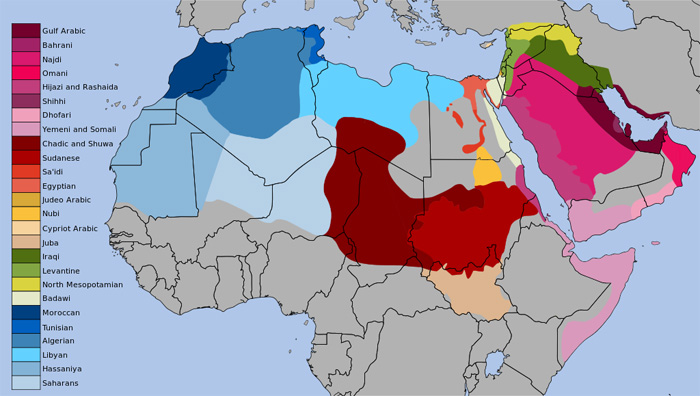Complete List of Arabic Speaking Countries – 2025 Update
In this article, we provide a complete list of Arabic speaking countries with the most recent statistics from 2024. Not only do we list Arab nations whose official language is Arabic, but also countries whose co-official language is Arabic. The first list provided is Arabic-speaking countries sorted in alphabetical order. This article also includes data on GDP, population, and sections for each dialectal group of colloquial Arabic. The same data is provided for countries with sizable populations of Arabic speakers or whose co-official language is Arabic.
Arabic Speaking Countries List in Alphabetical Order
| Country |
|---|
| Algeria |
| Bahrain |
| Egypt |
| Iraq |
| Jordan |
| Kuwait |
| Lebanon |
| Libya |
| Mauritania |
| Morocco |
| Oman |
| Palestine |
| Qatar |
| Saudi Arabia |
| Sudan |
| Syria |
| Tunisia |
| United Arab Emirates (UAE) |
| Yemen |
Brief Background on Arabic and the Arab World
As many as 491 million people worldwide speak Arabic, making it the fifth most spoken language. The word “Arab” means “nomad”, which makes sense considering Arabic originated from nomadic tribes in the desert regions of the Arabian Peninsula. Arabic language evolved from Nabataean Aramaic script and has been used since the 4th century CE. It is written from right to left, in a cursive style, and includes 28 letters similar to the English alphabet. Arabic belongs to the “Semitic” group of languages and is closely related to Hebrew and Aramaic. It has been preserved since the 7th century CE through the Prophet Muhammad’s revelations recorded in the Qur’an. By the 8th Century CE, Arabic began spreading throughout the Middle East and North Africa as many people converted to Islam. All Muslims are obliged to use Arabic in prayer. Today, the Arab world is a region composed of countries in the Middle East and North Africa where Arabic is an official language. Arabic speaking countries are immensely diverse from one another in terms of their history, culture, politics, and spoken dialects.
List of Arabic Speaking Countries by GDP
In total, Arabic-speaking countries have a collective GDP of $3.56 trillion. This is approximately 3.5% of the Gross World Product (GWP). Many countries in the Arab world are considered emerging markets. The Arab world is most notable for petroleum production, specifically in the Middle East. Saudi Arabia produces the second most amount of oil in the world with Iraq, UAE, and Kuwait ranking 6, 8, and 10 respectively. In Qatar, the Arab country with the largest GDP growth (4.8%), petroleum accounts for more than 70% of total government revenue, more than 60% of gross domestic product, and roughly 85% of export earnings. Though many of these countries’ economies largely depend on oil revenues, in recent years, nearly all the Gulf countries have enacted large-scale plans to diversify their economies, focusing on developing the private sector in an effort to reduce their dependence on oil for revenue. An example of another industry that is thriving in the Middle East can be found in Jordan, a country that does not have oil or other resources for energy production. Instead, services in Jordan account for more than 67% of GDP. The banking sector in Jordan is one of the strongest in the region. Arab Bank is one of the largest financial institutions in the Middle East and is headquartered in Jordan’s capital Amman. The Arab world is also diverse in regard to living standards. Qatar has one of the highest GDP per capita in the world at $71,570 whereas Yemen has one of the lowest at $465.
| Country | GDP 2024 (millions of USD) |
|---|---|
| Saudi Arabia | 1,067,583 |
| United Arab Emirates | 514,130 |
| Egypt | 396,002 |
| Iraq | 250,843 |
| Algeria | 247,626 |
| Qatar | 213,003 |
| Kuwait | 163,705 |
| Morocco | 144,417 |
| Oman | 109,990 |
| Sudan | 109,266 |
| Jordan | 50,967 |
| Tunisia | 48,530 |
| Bahrain | 46,080 |
| Libya | 45,096 |
| Syria | 23,623 |
| Lebanon | 20,992 |
| Palestine | 17,421 |
| Yemen | 16,190 |
| Mauritania | 10,652 |
| Total Arab countries GDP | 3,496,116 |
Arabic Speaking Frontier Markets & Least Developed Countries
There are a handful of Arabic-speaking countries that either fall into the category of a Frontier market or are considered a Least Developed Country (LDC). Frontier markets typically have large market opportunities and high potential for rapid growth. On the other hand these markets are often much riskier than established markets and the lack of infrastructure can make doing business complicated. Arabic LDCs are Arabic-speaking countries that show the lowest economic development. Countries like Syria torn by war actually experience contraction in their economy instead of growth and negative GDP as value flows out of the country. It’s important to note that even in these markets there are still some industries and products that do well and experience growth. The study of economics tells us that inferior goods are products that increase in demand as incomes decrease. Bus travel is an example of an inferior good that people turn to as their incomes decrease. That said, even some expensive products see a growth in demand in these countries while the economy contracts. For example Armored vehicles are in high demand in war torn Arab nations where safety is a primary concern.
Below is a list of 4 Arab countries that fall into this category.
- Libya
- Sudan (North)
- Syria
- Yemen
List of Arabic Speaking Countries by Population
The total estimated population of the Arab World is 491 million people (2024). This region stretches from Morocco in Northern Africa to Dubai in the Persian Gulf. Egypt is the most populous country in the region, and Bahrain is the least populous. Many countries in this region have very high population growth rates. For example, Oman and Qatar have population growth rates in the world at 1.5% and 0.8% respectively. Approximately 90% of people in the Arab world identify as Muslim, while 6% are Christian and 4% make up other various religions. The majority of people in this region are ethnically Arab but other major ethnic groups include Berber and Kurdish. Below is the complete Arabic Speaking Countries list sorted by population:
| Country | Population |
|---|---|
| Egypt | 116,538,258 |
| Sudan | 50,448,963 |
| Algeria | 46,814,308 |
| Iraq | 46,042,015 |
| Yemen | 40,583,164 |
| Morocco | 38,081,173 |
| Saudi Arabia | 33,962,757 |
| Syria | 24,674,760 |
| Somalia | 19,009,151 |
| Tunisia | 12,277,109 |
| Jordan | 11,552,876 |
| United arab emirates | 11,027,129 |
| Libya | 7,381,023 |
| Lebanon | 5,805,962 |
| Palestine | 5,495,443 |
| Oman | 5,281,538 |
| Mauritania | 5,169,395 |
| Kuwait | 4,934,507 |
| Qatar | 3,048,423 |
| Bahrain | 1,607,049 |
| Djibouti | 1,168,722 |
| Comoros | 866,628 |
| Total Arab population | 491,770,353 |
Other Arab Speaking Countries
Many countries also list Arabic as a Co-official language or have sizable Arabic speaking communities. However, Arabic is a minority language in all of these countries. For example, Chad has two official languages, French and MSA Arabic, as well as over 120 indigenous languages.
| Country | GDP (millions USD) | Population |
|---|---|---|
| Chad | 13,149 | 20,299,123 |
| Comoros | 1,352 | 866,628 |
| Djibouti | 4,099 | 1,168,722 |
| Eritrea | 2,065 | 3,535,603 |
| Israel | 513,611 | 9,387,021 |
| Somalia | 10,969 | 19,009,151 |
| South Sudan | 11,997,800 | 11,943,408 |
Dialects of Arabic
There are three forms of Arabic: Modern Standard Arabic (MSA), Qur’anic Arabic / Classical Arabic, and Colloquial Arabic. MSA is the official modern language of the Arab world and is derived from the Qur’an. MSA is widely taught in schools and universities throughout Arab speaking countries. It is also used to varying degrees in workplaces, government, and the media throughout the Arab World.
Despite the existence of MSA, Arabic-Speakers grow up speaking the dialect of their region. Every Arabic speaking country has its own form of colloquial Arabic that differs radically from MSA. A single dialect of colloquial Arabic may be common throughout an entire region or specific to one country. The major Arabic dialectal groups are:
| Dialect | Areas Spoken | Number of Speakers |
|---|---|---|
| Egyptian | Egypt | 78,000,000 |
| Gulf | Bahrain, Kuwait, Oman, Qatar, Saudi Arabia, UAE | 36,056,000 |
| Hassaniya | Mauritania, southern Morocco, south western Algeria, Western Sahara | 9,500,000 |
| Levantine | Lebanon, Jordan, Palestine, Syria | 54,000,000 |
| Maghrebi | Algeria, Libya, Morocco, Tunisia | 88,000,000 |
| Mesopotamian / Iraqi | Iraq, eastern Syria | 30,000,000 |
| Sudanese | Sudan, Southern Egypt | 37,000,000 |
| Yemeni | Yemen, Somalia, Djibouti, southern Saudi Arabia | 30,000,000 |
Arabic speaking countries in Africa
Arabic speaking countries in Africa include Egypt, Libya, Mauritania, Sudan, Tunisia, Morocco, Algeria, and Western Sahara.
Arabic speaking countries in Asia
Arabic speaking countries in Asia include Lebanon, Jordan, Palestine, Iraq, Kuwait, Saudi Arabia, Bahrain, Qatar, Oman, The UAE, and Yemen.
Non-Arabic speaking countries in the Middle East
Non-Arabic speaking countries in the Middle East include Israel, Turkey, and Iran. All three countries do have Arabic speaking residents but Arabic is not the first language of these Middle East countries.
Written by Scott Ridout
References:
World Economic Outlook Database
Population Analysis of the Arabic Languages
Updated by:



